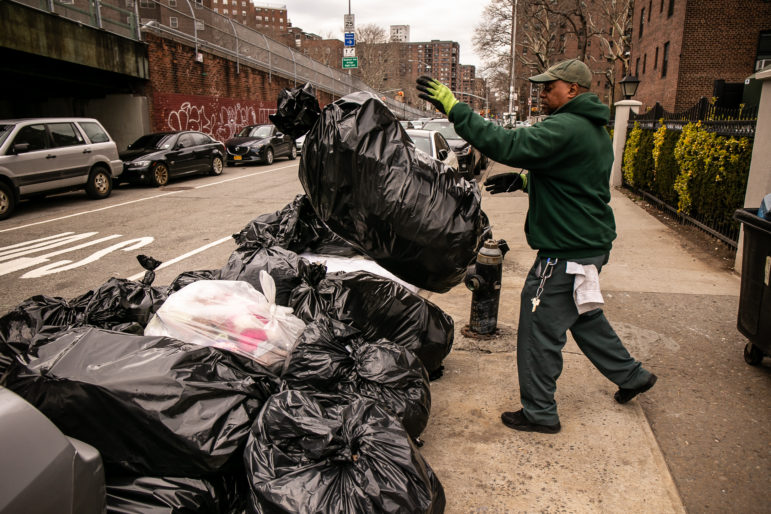“It’s an issue with statewide implications. Not only does Seneca Meadows accept trash from all around New York—30 percent of it comes from New York City—the landfill exports toxic leachate to Buffalo, Chittenango, Steuben County, Watertown, and Newark.”

Adi Talwar
Trash bags on the corner of East 135th Street and Park Avenue in Manhattan. Nearly a third of the waste that ends up in the Seneca Meadows landfill comes from New York City.New York has a major garbage problem. Waste is trucked around the state and dumped in huge landfills—like the state’s largest, Seneca Meadows—where local residents are left to cope with the grave environmental and health burdens of living next to a nearly 30 story tower of trash.
The Department of Environmental Conservation’s plan to address the issue is encapsulated in the Draft Solid Waste Management Proposal (DSWMP), which is open for public comment until June 29. The proposal is intended to protect communities and mitigate the effects of climate change by laying out a roadmap to reduce waste and advance the state’s transition to a circular economy. There is no doubt that we must implement more sustainable trash strategies, but the DSWMP doesn’t go far enough. Not included in the plan is closing Seneca Meadows.
READ MORE: Outsourced NYC Trash is Causing a ‘Never-Ending Odor Event’ Upstate, Lawsuit Alleges
Seneca Meadows is a polluting skyscraper of trash on the border of the towns of Seneca Falls and Waterloo. The Texas based, for-profit company that owns it—Waste Connections—has applied to the DEC to expand by another 47 acres and seven stories, and extend operations through 2040. The application is under review. If the DEC were to approve Seneca Meadows’ proposal to expand, it would directly undermine what the DSWMP sets out to achieve by creating more space for landfill waste.
It’s an issue with statewide implications. Not only does Seneca Meadows accept trash from all around New York—30 percent of it comes from New York City—the landfill exports toxic leachate to Buffalo, Chittenango, Steuben County, Watertown, and Newark.
Landfill leachate is one of four major sources of PFAS, which are found in thousands of household items, like non-stick pans, water-repellent clothing and stain resistant fabrics. When these items make their way into landfills, the PFAS contaminate the leachate. Known as “forever chemicals,” PFAS are human-made substances that build up and persist in the environment and our bodies. Exposure to PFAS is linked to harmful health impacts such as cancer, liver damage, decreased fertility, increased risk of asthma, and thyroid disease.
Last year, Seneca Meadows produced nearly 66 million gallons of PFAS laden leachate, 62 percent of which was shipped to Buffalo. The Buffalo Sewer Authority is on record admitting they don’t have the capacity or taxpayer funds to properly filter out PFAS. Seneca Meadows is driving a public health crisis across our state by shipping PFAS toxins to municipalities that are unable to filter them out of wastewater discharges.
Landfills are also the third largest source of methane, a global warming gas 21 times more potent than carbon dioxide. Seneca Meadows alone produces nearly a billion cubic feet of methane per year, and New York’s waste sector accounts for 12 percent of our state’s greenhouse gas emissions. That means closing the landfill would also be in line with New York’s nation leading Climate Law, which requires our state to reduce emissions by 40 percent by 2030.
New York City has stepped up to drive down organics in landfills in order to reduce landfill greenhouse gas emissions. On June 8, the City Council passed the Zero Waste Act. This package of bills codifies the goal of diverting 100 percent of recyclables and organic waste from landfills and incinerators, and creates a citywide, residential curbside organics composting program. But this can’t be a town by town or city by city fight. We need the state to step up and include closing Seneca Meadows in the DSWMP.
In fact, the majority of the surrounding Finger Lakes communities agree. Owen Marshall—a visiting assistant professor at Cornell University—analyzed all of the public comments submitted to the DEC about Seneca Meadows’ proposed expansion, and found that 99.6 percent of the comments were in favor of the landfill closing on schedule in 2025. That’s the date the landfill is set to close when their current permit expires.
But Waste Connections—SMI’s Texas based, for-profit operator—plays as dirty as the landfill they run. The company spent over $280,000 between 2019 and 2021 backing four of the five Seneca Falls town board members who support the landfill’s plan to expand and extend. Defeated local officials had previously supported closing the landfill in 2025. These races are usually run on a budget of a few thousand, if that.
If the intention of the DSWMP is to protect communities across the state and fight climate change, then closing Seneca Meadows must be part of the agenda. By shipping toxins around the state and spewing methane gas, allowing Seneca Meadows to expand their footprint and extend their operation will negate the goals the DSWMP sets out to achieve.
Gov. Kathy Hochul must honor the original decision of the Town Board and direct the DEC to both deny the expansion request and close the landfill in 2025. We can’t keep kicking the can on a meaningful waste reduction strategy down the road and into the landfill.
Yvonne Taylor is vice 0resident of Seneca Lake Guardian. Anne Rabe is NYPIRG’s environmental policy director.








